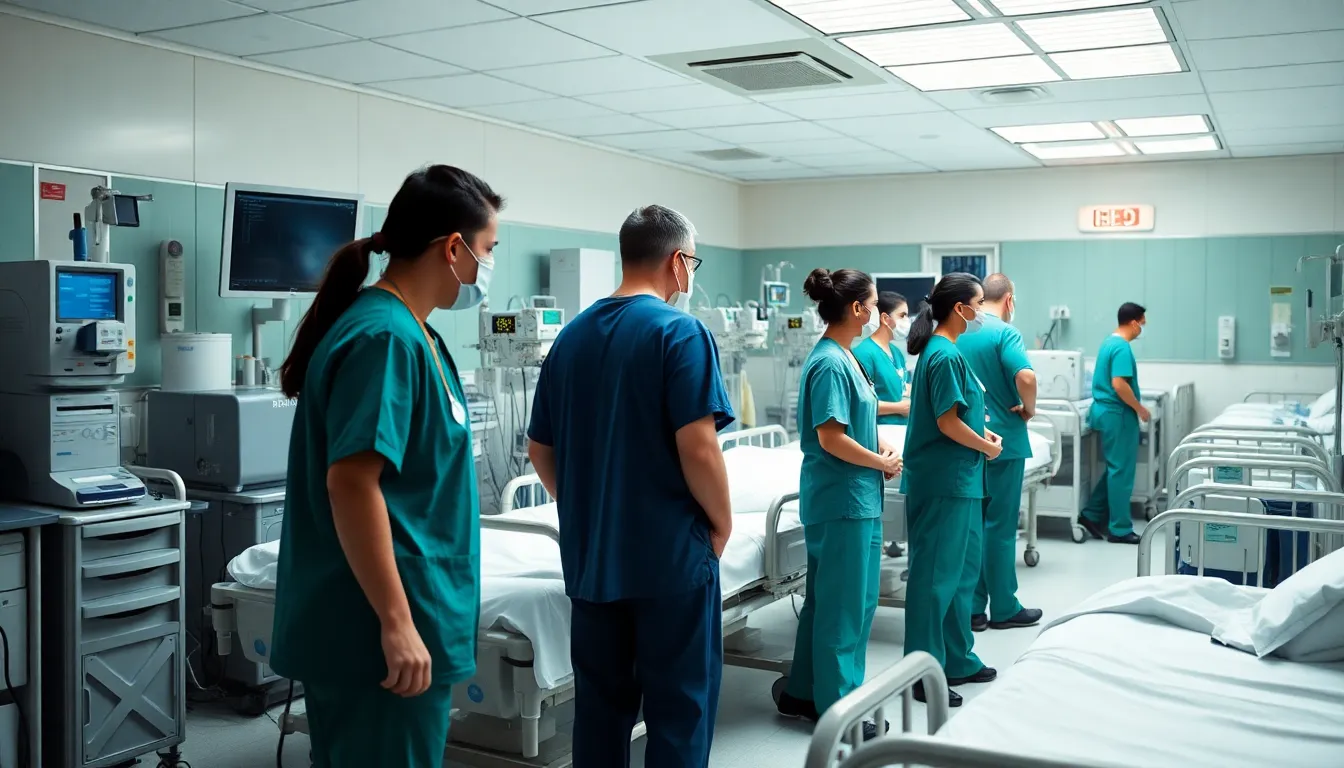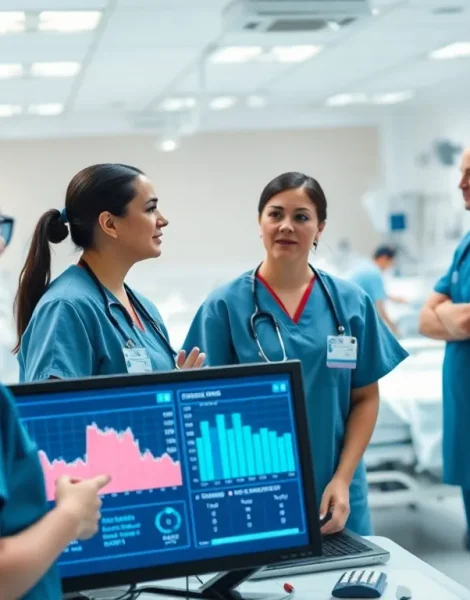In a world where hospital beds can feel as elusive as a unicorn, hospital capacity monitoring has become the superhero of healthcare management. Imagine a system that not only tracks available beds but also helps hospitals avoid the dreaded “sorry, we’re full” moment. It’s like having a backstage pass to the concert of patient care, ensuring everyone gets their turn on stage.
With the right monitoring tools, hospitals can stay one step ahead of patient influxes, making sure they’re ready for anything—from flu season to the latest viral trends. This isn’t just about numbers; it’s about saving lives and keeping the chaos at bay. So, let’s dive into the fascinating world of hospital capacity monitoring and discover how it’s transforming healthcare, one bed at a time.
Table of Contents
ToggleOverview of Hospital Capacity Monitoring
Hospital capacity monitoring serves as a crucial component in healthcare management. This process involves tracking available beds, staffing levels, and essential resources in real time. By utilizing advanced monitoring tools, hospitals can respond effectively to patient surges, particularly during peak times like flu seasons or health crises. Effective monitoring not only improves operational efficiency but also enhances patient care.
Data analytics play a significant role in optimizing hospital capacity. These analytics provide insights into trends and patterns related to admissions and discharges. Hospitals can predict high-demand periods, ensuring resources are allocated efficiently. For instance, predictive modeling can forecast patient influxes, enabling proactive adjustments to staffing and bed availability.
Collaboration among departments is vital for successful capacity monitoring. When teams share information, they streamline patient flow and minimize wait times. Each department needs to communicate effectively to ensure necessary resources are available when needed. Such synergy fosters a more organized approach to managing hospital operations.
Emergency preparedness hinges on accurate capacity insights. Hospitals equipped with real-time data can act swiftly in response to unexpected situations. Understanding capacity limits helps avoid overcrowding, which can compromise patient safety and quality of care. Implementing comprehensive monitoring systems enhances resilience during public health emergencies.
Incorporating technology into monitoring practices represents a leap forward for healthcare. Electronic health records and specialized software systems provide valuable data analysis. With enhanced visibility into a hospital’s operational status, leaders can make informed decisions that ultimately improve patient outcomes. Monitoring tools revolutionize the way hospitals approach capacity management, leading to safer, more efficient environments for care delivery.
Importance of Hospital Capacity Monitoring

Hospital capacity monitoring plays a critical role in the healthcare system. Accurate tracking of resources prevents overcrowding and ensures quality patient care.
Impact on Patient Care
Effective monitoring translates directly into improved patient outcomes. It helps hospitals manage bed availability, which reduces wait times for individuals requiring urgent attention. By analyzing real-time data on admissions and discharges, healthcare providers can anticipate patient surges, particularly during seasonal outbreaks. Prioritizing patient flow minimizes bottlenecks, leading to a smoother experience for patients and healthcare staff. Enhanced communication across departments enhances visibility into current statuses, allowing for swift decision-making that ultimately saves lives.
Resource Allocation
Efficient allocation of resources hinges on accurate capacity insights. Hospitals can better manage essential supplies and staffing levels when real-time data informs resource distribution. Monitoring tools enable leadership to assess which departments experience high demand and adjust resources accordingly. For instance, if a surge in emergency visits occurs, reallocating staff from less busy areas can help meet immediate needs. Proactive resource management not only improves operational efficiency but also optimizes staff workload, leading to better job satisfaction and retention rates. By leveraging data analytics, hospitals can enhance preparedness for unforeseen events, maintaining high standards of care even in challenging situations.
Technologies Used in Hospital Capacity Monitoring
Hospital capacity monitoring leverages advanced technologies to enhance efficiency and patient care. Various systems provide real-time insights into available resources and staffing levels.
Real-Time Data Systems
Real-time data systems play a crucial role in tracking bed availability and resource allocation. These systems continuously gather information from multiple sources within the hospital, ensuring staff stay informed about current capacity. Automated alerts notify healthcare personnel of changes in occupancy, enabling quick responses to patient surges. Integration with electronic health records further enriches data accuracy and load balancing across departments. By having instant access to this information, hospitals optimize workflows and reduce patient wait times.
Predictive Analytics
Predictive analytics empowers hospitals to anticipate patient needs and manage resources effectively. This technology analyzes historical data and identifies trends, such as peak admission periods during flu season. Hospitals can adjust staffing and resource availability based on these predictions, allowing for swifter decision-making during surges. Moreover, predictive models enhance emergency preparedness by simulating various scenarios and their potential impacts. With accurate forecasts, healthcare leaders can proactively respond to evolving situations, leading to improved outcomes and a smoother patient experience.
Challenges in Implementing Hospital Capacity Monitoring
Implementing hospital capacity monitoring comes with significant challenges, particularly in ensuring data accuracy and seamless integration with existing systems.
Data Accuracy and Reliability
Data accuracy impacts the effectiveness of capacity monitoring. If real-time information about bed availability and staffing levels is incorrect, decision-making suffers. Reliable data sources are essential for maintaining accurate records. Hospital staff must verify information regularly to foster confidence in the monitoring tools. Misleading data can lead to inefficient resource allocation, risking patient safety. Ensuring robust data governance and validation processes helps address these concerns. Staff education about the importance of accurate reporting fosters a culture of responsibility and diligence in data management.
Integration with Existing Systems
Integration poses another challenge in hospital capacity monitoring. Many healthcare facilities use disparate systems for managing patient information and resources. Unifying these systems allows for better data flow and visibility into hospital operations. Facilitating integration requires investment in technology and potential workflow changes. It’s crucial for hospital leadership to choose tools compatible with existing infrastructure. Training essential personnel on new systems ensures a smoother transition and maximizes effectiveness. Strong technical support can also assist with any integration hurdles, allowing staff to focus on patient care rather than technical difficulties.
Future Trends in Hospital Capacity Monitoring
Emerging technologies promise to enhance hospital capacity monitoring. Artificial intelligence and machine learning algorithms analyze data patterns, improving predictive capabilities. Hospitals can expect more sophisticated tools that provide real-time insights into patient flow and resource allocation.
Integration of Internet of Things devices facilitates better data acquisition. Wearable technology and smart sensors track patient movements and staff availability, providing comprehensive overviews of hospital operations. Automatic alerts derived from these devices empower staff to respond swiftly to changes in capacity.
Collaboration platforms enhance interdisciplinary communication. Teams can access shared dashboards, streamlining patient management across departments. Visualizing data in real time fosters a unified approach to decision-making.
Expanding telehealth services influences monitoring requirements. As more patients consult remotely, hospitals must adjust bed and resource availability to accommodate varying patient needs. Adapting capacity monitoring systems to include telehealth data promotes a more holistic understanding of demand.
Regulatory standards will evolve, focusing on standardized data reporting. Compliance with these standards ensures consistency across healthcare facilities, facilitating better benchmarking and resource sharing. Implementing an interoperable data infrastructure enhances overall efficiency in monitoring processes.
Sustainability initiatives shape future capacity strategies. Reducing resource consumption while maximizing operational efficiency becomes a priority. Hospitals increasingly emphasize environmentally friendly practices, innovating monitoring systems for better resource management.
Fostering patient-centered approaches influences capacity management trends. Engaging patients through feedback loops ensures services align with their needs. With a focus on personalized care, hospitals can optimize bed utilization and enhance overall patient experiences.
Continuous advancements in technology and data management signal an exciting future for hospital capacity monitoring. The future landscape will enable healthcare providers to respond adeptly to evolving demands, ultimately improving patient care and outcomes.
Hospital capacity monitoring stands as a vital component in modern healthcare management. By leveraging real-time data and advanced technologies, hospitals can effectively manage resources and enhance patient care. This proactive approach not only reduces wait times but also ensures that healthcare providers can respond swiftly to surges in demand.
The integration of innovative solutions like predictive analytics and IoT devices is set to transform capacity management further. As hospitals continue to adapt to evolving challenges, the focus on accurate data and interdisciplinary collaboration will be crucial. These efforts will not only improve operational efficiency but also create a safer environment for patients. The future of hospital capacity monitoring promises to deliver even greater advancements, ultimately leading to better health outcomes for all.








